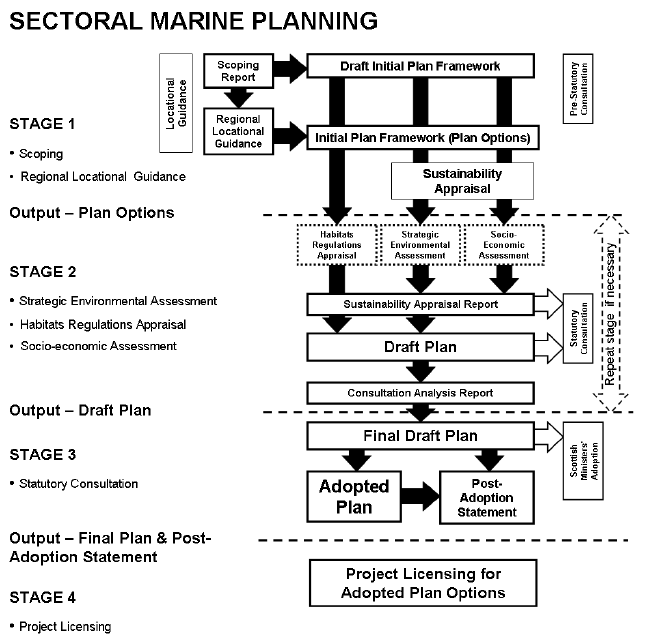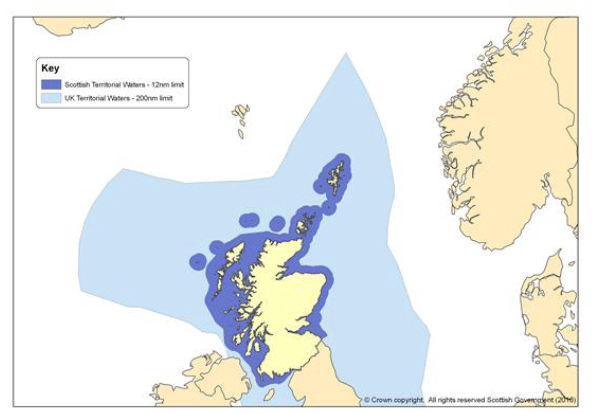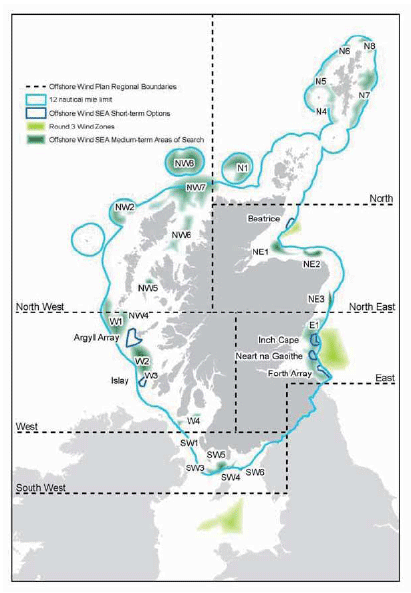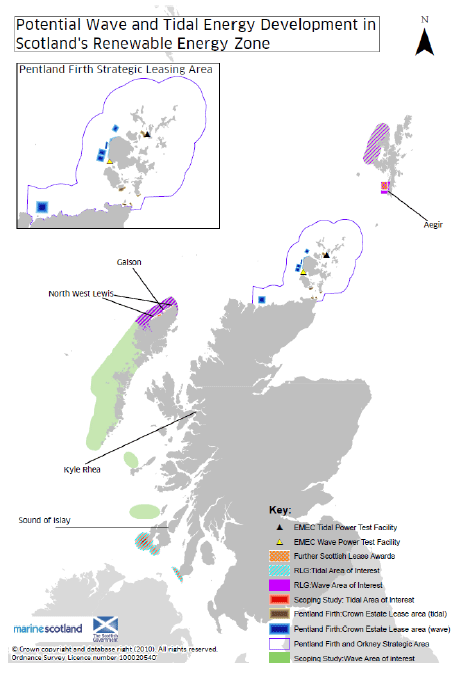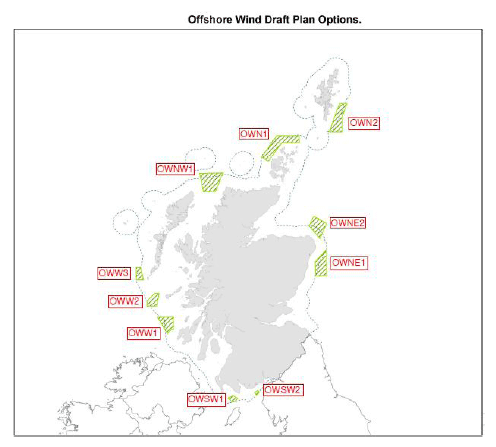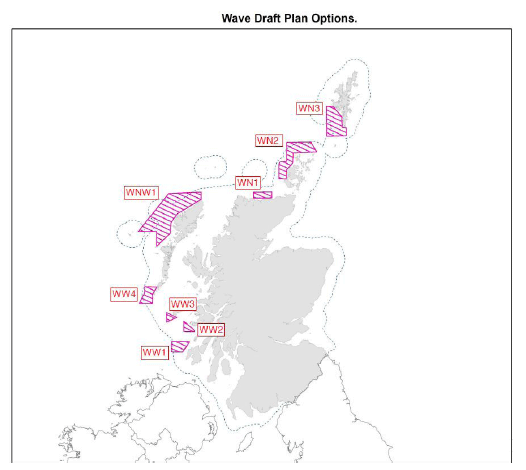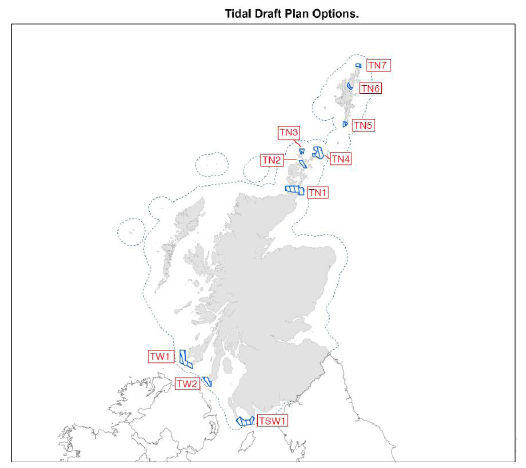Draft Sectoral Marine Plans for Offshore Renewable Energy in Scottish Waters- Strategic Environmental Assessment: Environmental Report and Appendix A
This Environmental Report documents the results of the Strategic Environmental Assessment (SEA) which is an assessment of the effects of the plans on relevant environmental receptors. In
this assessment the effects of the plan on the following have been
2 Introduction to the Assessment
2.1.1 Marine Scotland has developed a process of sectoral marine planning to identify the most sustainable locations in Scottish Waters for the development of commercial scale offshore renewable energy.
2.1.2 Separate plans are being prepared for wind, wave and tidal energy in Scottish Waters. Each of these plans is developed through a planning process which has been constructed through a staged approach [2] .
2.1.3 The scoping stage of the process was the first to be undertaken. This involved using the Crown Estate Marine Resource System ( MaRS) which is a GIS based system that has enabled Marine Scotland Science to undertake a technical and scientific exercise to identify areas of constraint and opportunity. The outcome of this was the identification of strategic search areas which were suitable for renewable energy development.
2.1.4 Building upon the scoping study, the next stage of the process was the development of draft Regional Locational Guidance ( RLG). At this point, consideration was given to more detailed environmental, technical and socio-economic issues in relation to the strategic search areas identified in the scoping study. The resultant information was then made available online for informal comment in draft locational guidance.
2.1.5 The areas of search were then published within draft Initial Plan Frameworks ( IPF). These early stage documents outlined the potential options for areas of search along with the process for developing the plan which includes a Sustainability Appraisal, comprising a Strategic Environmental Assessment ( SEA), Habitats Regulations Appraisal ( HRA), and Socio-Economic Assessment.
2.1.6 The draft RLGs and IPFs for the wind, wave and tidal plans were made available for an initial period of comment during a pre-consultation process that covered September and October 2012. The pre-consultation process involved workshops held with key sectoral stakeholders and organisations. Furthermore, regional workshops were held in 10 locations across the country in order to engage with members of the public.
2.1.7 The results of the consultation events and the information presented in the draft RLGs were used to refine the search areas included in the draft IPFs and developing options to be taken forward within the draft plan. Scottish Ministers' decided on the Draft Plan Options in January 2013.
2.1.8 The Draft Plan Options have been subject to SEA, which forms part of the Sustainability Appraisal, and this will further inform the development of a draft plans. Alongside the Sustainability Appraisal Report and the draft Plans, the SEA Environmental Report, will be subject to consultation with statutory consultees and the public. All consultation responses received will be compiled and presented in a Consultation Analysis Report. This document will also provide an analysis of the key issues arising.
2.1.9 The issues and responses arising from the consultation on both the plans and the Sustainability Appraisal Report will then be used to inform the Final Sectoral Marine Plans, which will be put before Scottish Ministers for adoption. When the plans are adopted, a Post-Adoption Statement will be produced which will provide an account of the development of the plan post consultation and an audit of consultation exercise. The full plan making process is depicted in Figure 2.1.
Figure 2.1 Sectoral Marine Planning
2.1.10 What follows within this report is the SEA of the Draft Plans for Offshore Wind Energy, Wave Energy and Tidal Energy in Scottish Territorial Waters.
2.2 The Draft Plan for Offshore Wind Energy in Scottish Waters
2.2.1 Marine Scotland is currently undertaking a review of its Sectoral Marine Plan for offshore wind energy development in Scottish Territorial Waters ('the draft Plan'). The draft Plan covers both Scottish territorial waters [3] and Scottish offshore waters [4] .
Figure 2.2 Map showing Scottish Territorial Waters and Scottish Offshore Waters
2.2.2 Scottish Ministers adopted ' Blue Seas - Green Energy: the Plan for Offshore Wind Energy in Scottish Territorial Waters' in March 2011 [5] . Blue Seas Green Energy set out a number of areas for offshore wind energy development including six 'sites' for development in the short term, and around 25 further 'areas of search' for consideration in the medium to longer term. It contained commitments to further research, data collection, stakeholder engagement and monitoring to accompany this programme of development. It also made a commitment to a 2 year review period, reflecting the fast pace of change within the offshore renewable sector.
2.2.3 Blue Seas, Green Energy considers the potential of Scottish territorial waters to accommodate offshore wind energy developments in the short, medium and long term, see Figure 2.3. It was also subject to a Sustainability Appraisal which comprised a SEA [6] , HRA [7] and socio-economic assessment [8] .
Figure 2.3 Areas of search identified in 'Blue Seas, Green Energy' (2011)
2.2.4 Blue Seas Green Energy was developed in consultation with key stakeholders, including industry and environmental stakeholders. A commitment was made to review the plan within 2 years of its initial adoption. The 2011 Offshore Wind Plan stated that the review would consider broadening the geographic scope of the Plan to cover Scottish Waters out to the 200 nautical mile limit. It also included a commitment to a detailed review and testing of the way in which medium term development areas were identified within the first plan.
2.3 The Draft Plans for Offshore Wave and Tidal Energy in Scottish Territorial Water
2.3.1 At the same time as the aforementioned review, Marine Scotland is also commencing preparation of two Sectoral Marine Plans for Wave and Tidal Energy in Scottish Territorial Water. Both plans will cover Scottish territorial waters and Scottish offshore waters.
2.3.2 A Marine Renewables SEA was undertaken during 2004-06 and an Environmental Report was published in 2007 which examined the environmental effects of developing wave and tidal power. This informed the preparation and delivery of the Scottish Government's strategy for the development of marine energy in Scotland's marine environment out to 12 nautical miles. This SEA is therefore being undertaken as a 'maintenance exercise' to take account of policy developments in the Scottish marine renewables sector and will build on the conclusions of the 2007 SEA.
2.3.3 The 2007 SEA also provided marine developers with data on the most appropriate and best locations to place wave and tidal devices on the north and west coasts of Scotland; setting out the issues which had to be tackled to facilitate the breakthrough of the wave and tidal energy sectors. The reports from the SEA and responses to the consultation are available to view online at: http://www.scotland.gov.uk/Publications/2007/03/seawave.
2.3.4 The 2007 SEA reported that there were considerable marine renewable energy resources around Scotland and that there were also significant levels of existing users and constraints within the marine environment. The SEA highlighted that the sector would require locational guidance and simplified regulation and that uncertainties concerning environmental interactions with new technology deployments would need to be addressed.
2.3.5 In July 2011 a SEA scoping study was undertaken on the development of a Sectoral Plan for Wave and Tidal Energy in the Scottish Renewable Zone. Since that scoping study a decision has been made to produce separate plans for Wave and Tidal Energy. The scoping study explained that ongoing studies have been undertaken by The Crown Estate ( TCE) and Marine Scotland to identify suitable areas in Scottish territorial waters for wave and tidal development.
2.3.6 The draft plans for Wave and Tidal Energy will build on the areas identified to date (shown in Figure 2.4) which have the potential to be classed as areas for development.
- The eleven Pentland Firth and Orkney Waters ( PFOW) agreement areas;
- The five areas of interest identified through the Saltire Prize Programme;
- Regional Locational Guidance work; and
- The three sites included in TCE's Further Scottish Leasing Round announced in May 2011.
Figure 2.4: Initial Wave and Tidal Areas of Energy Potential
2.4 The Relationship with Emerging Plans for Offshore Wave and Tidal Energy
2.4.1 As noted in Section 2.1, the review of the Plan for Offshore Wind Energy in Scottish Territorial Waters has been undertaken alongside the production of new Sectoral Marine Plans for Wave and Tidal Energy technologies. These draft plans ('the draft plans') have also been subject to Sustainability Appraisal and the findings of the SEA for each technology are reported in this Environmental Report which, together with all three plans, are the subject of statutory consultation.
2.4.2 This Environmental Report also contains a cumulative effects assessment of the Wind, Wave and Tidal Plans. The findings of that assessment have been used to inform the Sustainability Appraisal.
2.5 This Strategic Environmental Assessment ( SEA)
2.5.1 The draft plans fall within the parameters of the Environmental Assessment (Scotland) Act 2005, Section 5(4) whereby it is necessary to conduct an SEA. The SEA screening undertaken by Marine Scotland determined that the plans all had the potential to give rise to significant environmental effects, therefore that a full environmental assessment was required [9] . Marine Scotland also carried out SEA scoping exercises to identify the scope and level of detail of the assessments [10] .
2.5.2 Given the potential scope of the plans' geographic impacts, the SEA has been undertaken in accordance with both the requirements of the Scottish Environmental Assessment (Scotland) Act 2005 and the UK Environmental Assessment of Plans and Programmes Regulations 2004.
2.5.3 This Environmental Report now accompanies the Sustainability Appraisal Report for consultation alongside the draft plans. Following the consultation, a report summarising the consultation findings will be published, and the plans will be finalised.
2.6 The Relationship to the Habitats Regulations Appraisal ( HRA)
2.6.1 A HRA is required under the Conservation (Natural Habitats, &c.) Regulations 1994 (as amended). The HRA is an appraisal of the potential for the plans to impact on sites designated under the European Habitats or Birds Directives as Special Areas for Conservation ( SAC) or Special Protection Areas ( SPA). The process has identified whether the Draft Plan Options have the potential for likely significant effects on European sites, either alone or in-combination. Areas of search which were found to have the potential for likely significant effects were then subject to an 'appropriate assessment' which considered the draft plans' implications for the European sites in view of the sites' conservation objectives. A view was then taken on whether the draft plans will avoid adverse effects on the integrity of European sites.
2.6.2 It is also a requirement of SEA to consider impacts on European sites and as such the SEAs have drawn on the HRA work undertaken in considering the potential for significant environmental effects.
2.7 The Relationship to the Sustainability Appraisal ( SA)
2.7.1 As previously detailed the SEA and the HRA will form the environmental pillar of the integrated Sustainability Appraisals for the draft plans while the socio-economic assessment will provide information on the other aspects of sustainability.
2.8 Draft Plan Assessment and Reasonable Alternatives
2.8.1 The first stage of consideration of alternatives was to set out the potential environmental effects associated with a range of different offshore wind, wave and tidal technologies that are currently considered to have potential for implementation in Scottish marine waters. Once the potential type of effects arising from the alternative technologies were identified, these were then applied to spatial and locational constraints identified in the baseline data for each of the Draft Plan Options for wind, wave and tidal power. This helped to identify the type of effects that might be expected to occur within the Draft Plan Options should subsequent project implementation go ahead.
2.8.2 The draft plans contain options refined from the areas of search following the period of pre-consultation which are set out in Figures 2.5 - 2.7. The Draft Plan Options form the alternatives for consideration within the assessments. The options provide a set of locations to which environmental constraints and receptors can be attributed. The naming system is that applied and referred to in the assessment of the Draft Plan Options set out in Appendix D.
Figure 2.5: Draft Plan Options for Wind Energy
Figure 2.6: Draft Plan Options for Wave Energy
Figure 2.7: Draft Plan Options for Tidal Energy
2.8.3 A third stage of alternatives has been considered, essentially broad scenarios for the potential occupancy of technologies within the Draft Plan Options. The scenarios, originating from the accompanying socio-economic assessment, effectively give low, medium and high scenarios that give an indication of how an individual Draft Plan Option may be developed at project implementation. Details of the scenarios are given in Table 2.1. The scenarios were used within the context of the cumulative impact assessment to help gauge the potential level at which renewables devices could be deployed across the Draft Plan Options. The occupancy scenario alternatives enables the assessment to consider whether the magnitude of an effect is altered by smaller or larger areas of development, or whether an effect is related simply to the presence of devices and independent of the areas of development.
Table 2.1: Indicative occupancy scenarios for wind, wave and tidal energy
| Scenario |
Wind Indicative Occupancy (%) |
Wave Indicative Occupancy (%) |
Indicative Occupancy (%) |
|---|---|---|---|
| Low |
4.8 - 26.5 |
0.2 - 0.6 |
0.8 - 2.5 |
| Medium |
11.6 - 26.5 |
0.5 - 0.6 |
2.6 |
| High |
25.1 - 26.5 |
1.0 |
5.1 |
2.8.4 In summary the assessment has been undertaken using the following stages of alternatives assessment:
- Stage 1: Identify the range of environmental effects associated with alternative offshore wind, wave and tidal technologies.
- Stage 2: Identify environmental effects of applying the range of effects identified in Stage 1 to the alternative Draft Plan Options.
- Stage 3: Cumulative impact assessment and assessment of the potential effects associated with the alternative scenarios for occupancy.
2.9 Structure of this Environmental Report
2.9.1 The structure of this document is set out as follows:
- Section 1: Non-Technical Summary
- Section 2: Introduction to the Assessment
- Section 3: The Approach to the Assessment
- Section 4: Context and Legislation
- Section 5: Environmental Baseline
- Section 6: Environmental Assessment
- Section 7: Recommendations, Mitigation and Monitoring
2.10 Summary
2.10.1 A summary of the details of the draft plans which are the subject to the SEA are provided below.
| Name of Responsible Authority |
Marine Scotland. |
|---|---|
| Title |
Sectoral Marine Plans for Offshore Wind, Wave and Tidal Energy in Scottish Territorial Waters. |
| Purpose |
To provide a framework for the development of commercial scale offshore wind, wave and tidal energy in the waters around Scotland. |
| What prompted the PPS |
A commitment was made to reviewing the Plan for Offshore Wind Energy in Scottish Territorial Waters (2011) every 2 years. Commitment to produce plans for wave and tidal energy. |
| Subject |
Renewable energy, marine environment. |
| Period covered |
Not specified. |
| Frequency of updates |
Future review cycles have not yet been identified. |
| Area covered by PPS |
Scottish Waters (0 to 200 nautical miles from shore) |
| Summary of nature / content |
The Plan will identify potential areas for offshore wind energy development. |
| Purpose and/or objectives of PPS |
To optimise the sustainable development of offshore energy in the marine environment. |
| Contact point |
Lewis Hurley |
Contact
There is a problem
Thanks for your feedback
